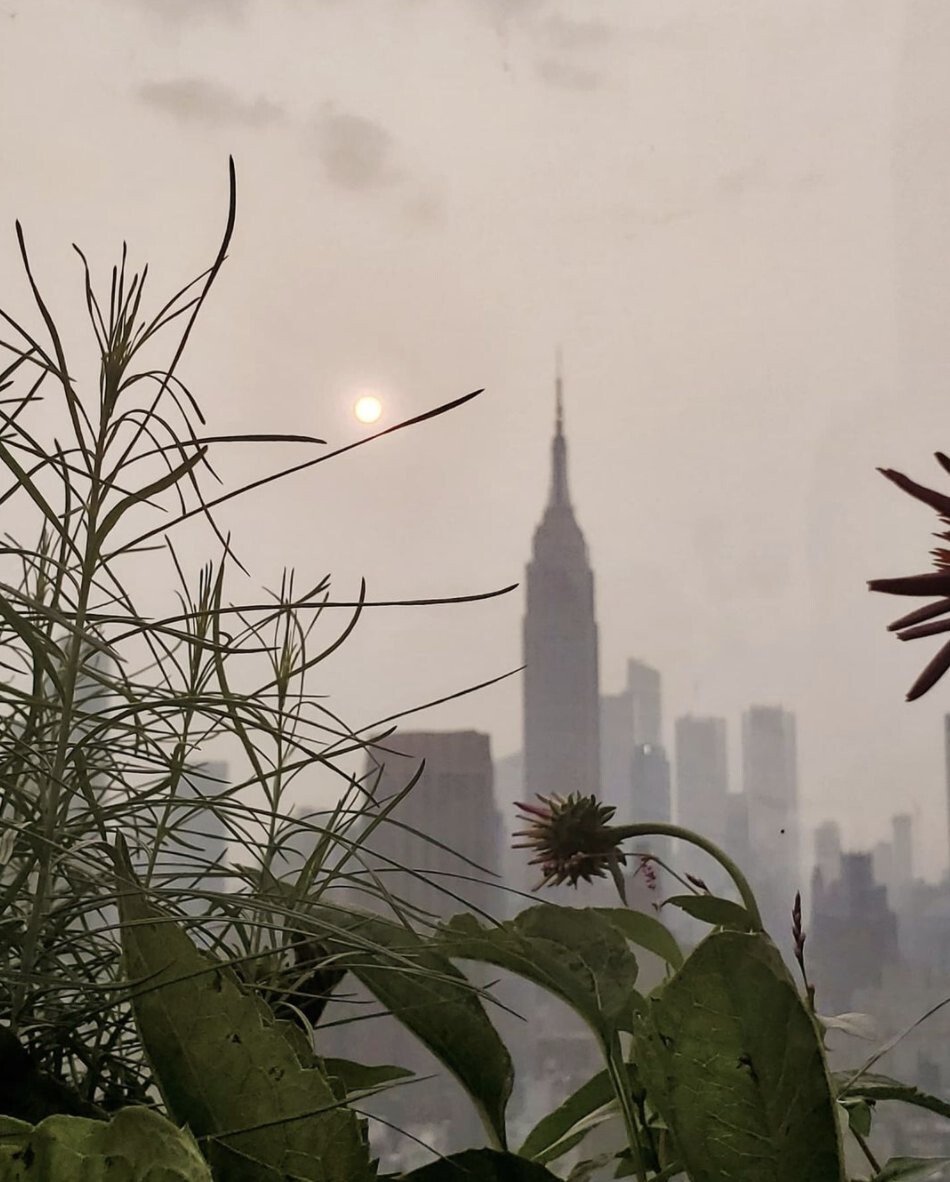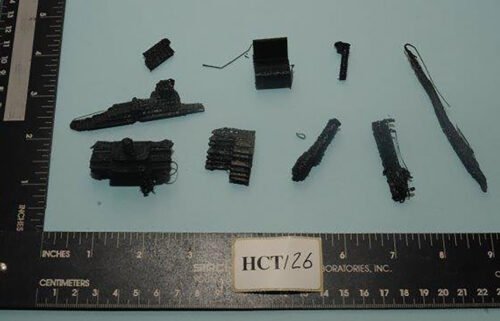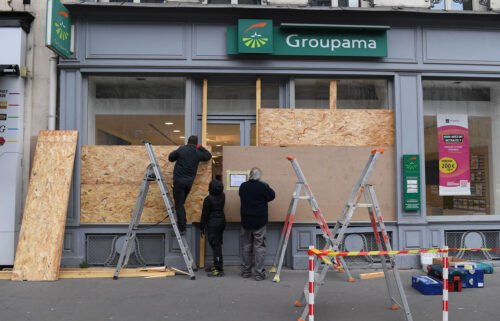Western wildfire smoke is contributing to New York City’s worst air quality in 15 years

By Hollie Silverman, Michael Guy and Joe Sutton, CNN
Extreme heat and dry conditions are fueling raging wildfires in the western US, charring more than a million acres, requiring evacuations and creating smoky conditions visible from space.
Smoke stretched early Wednesday all the way to the East Coast, including New York City, because high-level winds carried them thousands of miles from the West.
The smoke mixed down to the surface in New York City, creating an eerie scene Wednesday morning.
The city had a 24-hour average Air Quality Index of 154 on Tuesday, the worst it’s been since June 2006, when the AQI was 157.
The good news is a cold front is ushering the smoke out of the area. And some rain was helping out Wednesday afternoon.
And in Indiana, the Department of Environmental Management asked residents to reduce their activity time outdoors on Wednesday and Thursday. Forecasts predicted high levels of fine particles in the air due to the wildfire smoke, officials said in a news release.
In the West, the fires have caused power outages, destroyed structures and prompted the deployment of the Oregon National Guard.
As extreme drought still grips most of the West and the fires have become so intense they’ve created their own weather systems, the threat of more fires remains.
How to support Western wildfire victims
In Oregon — where seven active large fires have burned nearly 467,000 acres — officials said the current fire season is unlike any they’ve seen before.
“I would categorize this fire season thus far as historic in terms of the amount of resources we’ve deployed, how many times we’ve deployed — within a three-week period we’ve mobilized to six conflagrations — and this is the earliest and most significant mobilization to date,” State Fire Marshal Mariana Ruiz-Temple said Tuesday.
At least 1.35 million acres have burned in 78 active large fires across 13 states as of Wednesday, according to the National Interagency Fire Center. More than 20,000 firefighters and support personnel are deployed to deal with the blazes.
Advisories for elevated fire potential and activity have been issued across Idaho, California, Oregon and the Northern Rockies, according to fire center officials.
It’s not just fires in the US contributing to the smoky haze. The Canadian province of British Columbia declared an emergency due to wildfires there effective Wednesday. Nearly 300 active wildfires have been reported in the province.
Bootleg Fire is largest in country
In Oregon, record-breaking, triple-digit temperatures and severe drought have devastated parts of the state.
The conditions are fueling the Bootleg Fire in southern Oregon, which is the largest burning wildfire in the country. The Bootleg Fire has scorched more than 395,400 acres and prompted evacuations with only 32% containment, according to InciWeb, the US clearinghouse for wildfire information.
Lower wind speeds and temperatures, and slightly higher humidity Tuesday gave firefighters an advantage, allowing them to continue constructing and improving fire lines, according to Wednesday’s Joint Information Center daily update.
More than 2,200 personnel are involved in firefighting efforts.
Firefighters continue to work the southeastern corner of the blaze where the majority of recent growth has occurred, according to the update.
“Returning residents to these areas may see unburned fuels within the fire perimeter that will continue to burn and produce smoke for weeks,” fire officials said.
Campfires will be banned in all state parks and state-managed forests east of Interstate 5 starting Thursday, the Oregon Parks and Recreation Department announced Wednesday. That covers all regions of the state except the Pacific coast and a portion of the Willamette Valley.
The ban includes not only charcoal and propane fires, but also tiki torches and even candles.
The climate crisis has made deadlier and more destructive wildfires the new normal. And Oregon Gov. Kate Brown cited recent fires, ice storms, record-breaking high temperatures and drought emergencies as evidence that climate change is impacting her state.
“There’s absolutely no question that climate change is playing out for before our eyes,” Brown said at a news conference Tuesday. “We saw the heat dome event a few weeks ago; we unfortunately lost a lot of Oregonians through that event. In February, we saw devastating ice storms, over a half a million people lost power last fall, as you are well aware. We’ve had unprecedented wildfires.”
Fire potential in the state is being driven by drought conditions, with 90% of Oregon in either exceptional, extreme or severe drought, Doug Grafe, chief of fire protection at the Oregon Department of Forestry, said while forecasting a “long, difficult fire season.”
He said it’s possible that another 50,000 to 100,000 acres could burn before the Bootleg Fire is contained.
“The future for us for the remainder of the season continues to look above normal dry and above normal temperatures,” Grafe said. “So this is not going to return to normal anytime soon.”
Red flag warnings in the area will continue into Wednesday evening, signaling dry and windy conditions with lots of smoke, CNN meteorologist Michael Guy said.
As a result of the fires, 62 members of the Oregon National Guard have been deployed, along with Blackhawk helicopters to provide water drops, fire spotting and medevac support, Maj. Gen. Michael E. Stencel, adjutant general of the Oregon National Guard, said.
In addition to feeding fires, Oregon’s hot, dry conditions are also impacting Christmas trees grown in the state.
“It’s killing them,” Jacob Hemphill, a Christmas tree farmer in Clackamas County, said of the relentless heat this summer. “It’s horrible, there is nothing we can do.”
Unusually warm temperatures and severe dryness this year have caused irreversible burns on many trees, resulting in fewer trees to choose from this upcoming holiday season as well as potentially higher prices, growers said.
California’s Dixie Fire may have been sparked by electrical equipment
Farther south, the Dixie Fire has burned more than 85,000 acres in Butte County, California, after igniting last week, according to the state department of forestry and fire protection, or Cal Fire. It is approximately 15% contained.
Butte County is the site of California’s deadliest and most destructive wildfire in 2018, the Camp Fire. It destroyed 18,804 structures and killed 85 people.
The Dixie Fire is so intense, it produced a thunderstorm, incident meteorologist Julia Ruthford said in a briefing Monday night. “The fire actually generated a thunderstorm over itself that led to some lightning out ahead of it and some really gusty and erratic winds due to that extreme, extreme conditions due to the thunderstorm overhead,” she said.
Evacuations have been ordered in the area and the fire already destroyed two structures and threatens more than 800 others.
On Tuesday, Pacific Gas and Electric said the fire may have been sparked by equipment it manages.
In a preliminary filing with the California Public Utilities Commission, PG&E detailed an outage alert July 13, the same day the fire started. A responding utility worker found three blown fuses and a tree leaning into a pole, with a small fire on the ground near the base of the tree.
The fire was reported to authorities and Cal Fire sent aerial firefighters to douse the flames, which had jumped from an initial estimate of 1 to 2 acres, to 10 to 15 acres, according to the filing.
Since then, the fire has grown exponentially, burning in “remote areas with limited access and steep terrain,” Cal Fire said, which is hampering access by ground crews.
Near the California-Nevada border, the Tamarack Fire, has grown to nearly 39,045 after sparking July 4, according to information from InciWeb.
A lightning strike near the Alpine County, California, community of Markleeville started the fire, which has triggered mandatory evacuations for a number of campgrounds and neighborhoods and prompted road closures.
The-CNN-Wire
™ & © 2021 Cable News Network, Inc., a WarnerMedia Company. All rights reserved.
CNN’s Jackson Dill, Kay Jones, Chris Boyette, Stella Chan, Jason Hanna, Brisa Colon, Cheri Mossburg, Melissa Alonso, Andy Rose, and Kendall Lanier contributed to this report.



